
 |
| This is a non-commercial web site. Advertising is not accepted. I am not being paid for any mention or promotion. |
| To translate this page from English select a language |
 happiness |
808
Car Keys Micro Camera Review hope it can help your life safe and happiness |
 happiness |
| 130307 - 808 #3, No MAC webcam |
| Many (most) newer
enumerated versions of the 808 cameras do not require a webcam
driver. The #3 has been around for about 4 years and does require a webcam driver. Only a PC driver has been offered by the producer. |
| 120820 - 808 #3 Horizontal FOV is About 34 Degrees |
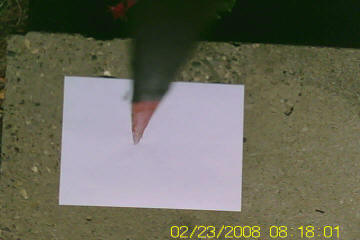 34
degrees - The horizontal FOV (Field Of View) of the 808
#3 for both video
and photos. It is possible that suppliers could use various lenses so YMMV. 34
degrees - The horizontal FOV (Field Of View) of the 808
#3 for both video
and photos. It is possible that suppliers could use various lenses so YMMV.34 degrees - The FOV of a 59mm lens on a 35mm film camera. 56 to 90 degrees - The 808 #16v2 is available with various lenses and FOV. See how to measure. Video frame arctan(( 720*11)/(2*36*363))*2 = 33.7 Photo frame arctan((1280*11)/(2*36*638))*2 = 34.1 The #3 uses the OV7670 image sensor with image area of 2.36 x 1.76mm and the diagonal is 2.94mm. A 35mm film frame diagonal is 43.3mm. So the 808 #3 lens factor is about 14.7 (43.3/2.94). |
| 111204 - #3 Report |
| 120723 - Steve in the
UK says this is probably a #6, not a #3, because the circuit
board matches his #6. Claudio from France wrote: I recently bought a 808 camera on ebay from the globalink2010 seller; he advertises the camera as #3 and indeed from the time stamp and the low missing frames (about 10 %) it seems a real #3, maybe a newer version, since the PCB is slightly different from the ones found on your site for the #3; I'm including a picture of mine, just for reference. I have also measured the approximate current drawn under different conditions: 25 uA when off. 130 mA when on, but not recording. 160 mA when recording a video.  |
| MD80C3Schematic |
| 111113 - MD80 (808 #3) Schematic |
| I received an email with an attached MD80 schematic. The MD80 is very similar to the 808 #3 but in a different package. The schematic should be useful to anybody modifying an MD80 or 808 #3 camera. |
| C3WhereToBuy | ||||||||||||||||||||||||||||||||||||||||||||||||||||||||||||||||||||||||||||||||||||||||||||||||||||||||||||||||||||||||||||||||||||||||||||||||||||||||||||||||||||||||||||||||||||||||||
| 110714 - Sellers of the #3 camera | ||||||||||||||||||||||||||||||||||||||||||||||||||||||||||||||||||||||||||||||||||||||||||||||||||||||||||||||||||||||||||||||||||||||||||||||||||||||||||||||||||||||||||||||||||||||||||
 101122
- An 808 seller in the UK reports this good news:
We have had many problems sourcing reliable #3 cameras,
those that we do get have had sound and charging problems.
However, one supplier today sent us this: "Within 2 month
we will complete the re-design for #3camera, we will improve
the charging problem and sound problem" Another supplier
has also informed us that they will be stocking the #3
again. So it looks like the #3 is back in production one
way or another. 101122
- An 808 seller in the UK reports this good news:
We have had many problems sourcing reliable #3 cameras,
those that we do get have had sound and charging problems.
However, one supplier today sent us this: "Within 2 month
we will complete the re-design for #3camera, we will improve
the charging problem and sound problem" Another supplier
has also informed us that they will be stocking the #3
again. So it looks like the #3 is back in production one
way or another. 101121 - eBay enjoy-secret claims to have 1000 #3 cameras for sale! 101010 - Reports are that the great #3 is no longer in production, and most sellers have run out of the #3. Caution - some sellers on eBay who listed and sold the #3 are still listing a #3, but delivering something else. IMHO the #6 is very similar to the #3 and is the next best camera. After the #6 the #8 is the next best camera but users have reported some audio problems. The #3, #6 and #8 are all based on Sunplus processors. I regularly get the question: Where can I buy a #3 camera? Most of the sellers on eBay are in China and they don't identify the version of camera that they sell, but they have the best price. The best strategy to buy from a China seller is to watch the forums (like this one) to find out who bought a #3 and from whom, and then order one and hope that it is a #3. |
||||||||||||||||||||||||||||||||||||||||||||||||||||||||||||||||||||||||||||||||||||||||||||||||||||||||||||||||||||||||||||||||||||||||||||||||||||||||||||||||||||||||||||||||||||||||||
|
You can also order from a seller that advertises a #3. These sellers
might have a higher price but offer more services. Some
fully test the camera before shipping it to you. If you
and the seller are
in the same country you will receive it in a few days.
This version is so popular, they are often out of stock. |
||||||||||||||||||||||||||||||||||||||||||||||||||||||||||||||||||||||||||||||||||||||||||||||||||||||||||||||||||||||||||||||||||||||||||||||||||||||||||||||||||||||||||||||||||||||||||
|
Sellers of the #3 by version.
|
||||||||||||||||||||||||||||||||||||||||||||||||||||||||||||||||||||||||||||||||||||||||||||||||||||||||||||||||||||||||||||||||||||||||||||||||||||||||||||||||||||||||||||||||||||||||||
|
Selling the #3 Camera ● WingmanRC, Arizona, USA 101121 - Out of Stock ● BazaarLee, UK 101121 Not selling ● Bob Skinner, Colorado, USA (email: keycam@startflyingrc.com) 101121 Not selling ● marktech101, North Carolina, USA (rcgroups) 101121 - Not selling ● linjiechong in Hong Kong is selling the #3 by version. 101121 - Selling the #8. Not selling the #3 ● 110609 Not selling any 808 camera. 101120 This eBay seller (enjoy-secret) is selling a #3 by version and claims to have 1000 in stock! I have no buyer reports yet. ● 110601 THEMICROCAMERA.COM is selling the 808 #3 and the 808 #11. Caution about these sellers ● 100926 - eletoponline365, China - This eBay seller has been selling the 808 camera for many months. Now describing the camera explicitly as "The Camera Version is #3, Date Time Stamp is lower right and yellow color." eletoponline365 claims to sell the #3 but recently delivered a #6 to a buyer in Germany (the #6 is also a good camera). When asked about this eletoponline365 replied (100926): Dear friend, i can't also belive it. it can't be happened. we even don't have #6 in storage. we do really send #3,please trust us. i'll have a check and ask our technicians in our company about this problem. sincerely thank you for reminding this. have a nice day. yours sincerely - eletoponline365 ● Meritline has been delivering the #9 camera. a variant of the #5 camera Meritline describes the camera as "The processor is Sunplus (#3)". I have contacted Meritline about this. Reported to be selling the #11 (808 HD 1280x720): List of #11 sellers. |
||||||||||||||||||||||||||||||||||||||||||||||||||||||||||||||||||||||||||||||||||||||||||||||||||||||||||||||||||||||||||||||||||||||||||||||||||||||||||||||||||||||||||||||||||||||||||
|
| C3OpenSourceFwProj |
| 110705 - #3 Open Source Firmware Project |
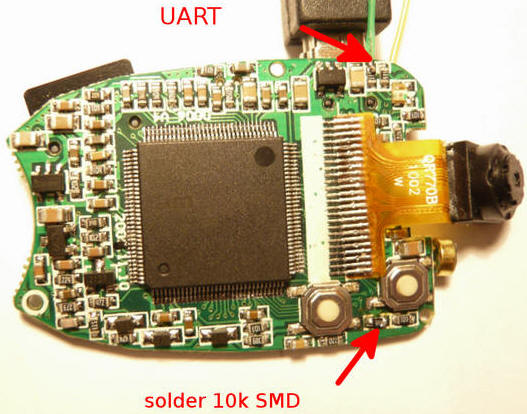
808 #3 by soldering a 10K resistor as shown the camera outputs debug info. UART 56K 3.3V Stefan discovered that the camera can output debug information in UART 56K 3.3V format. This feature is activated by soldering a 10K resistor. See the photo. https://github.com/mandl/808MicroCam/wiki/808-Micro-Camera-Firmware Sample UART output spiBoot 1c3114 Ld Ok TK B F/W version is T32 V272-00 F/W compiled @ 08/09/10, 10:23:59 1c3114 diskPhySectors 0xb0,G_SPI_CisBlockAddress=ea IOTrap 84 Msg(2) SD card Insert! Msg(40) Msg(40) L1_Storage.c 130, isSdVer2=1, SD, arg=40040000 OCR: C0 FF 80 00 SDHC CID: 03 53 44 53 55 30 34 47 80 51 56 85 24 00 AB 27 CSD: 40 0E 00 32 5B 59 00 00 1D 8A 7F 80 0A 40 40 B9 tTAAC=1(ms) tNSAC=0(clk) sd\sd533.c 214, rwFactor=8 SD Ver=0 48MHz total=1, cur=100 No text file! Msg(3) still view init Msg(42) Msg(b) SS |
| 110505 - Sunplus SPCA1527 Schematics (808 #3 and 808 #6 processor) processor) |
| Alexander in Russia sent
me these links to Sunplus (GenPlus, iCatch) SPCA1527 / SPCA1528
documents. Unfortunately the links are to a view of aPDF
that can't be downloaded without a Baidu account. Comment from Alexander: These links to datasheets with pinouts of processors, maybe they would more useful for people ? As for me, it is interesting to get an analog video out directly from #8 camera (it seems to me, the EKEN002 processor must be similar with SPCA 1527, but it needed to found out 
 http://wenku.baidu.com/view/4c13fb01b52acfc789ebc9d3.html - SPCA1527A sample schematic development configuration. First SPCA1527A schematic that I have seen. http://wenku.baidu.com/view/8032f51414791711cc791727.html - 32 page Sunplus mMedia SPCA1528A (like SPCA1527A )DataSheet |
| 110331 - #3, USB Amperage, no LiPo |
| I received a request to
measure the USB Vcc amperage if the camera LiPo battery was not
present. Here are the bench results for one of my #3
cameras with ground and Vcc (+5) connected and data lines
optionally disconnected. The unloaded USB Vcc was 5.21 V. 125 mA with the USB data lines connected. 125 mA with the USB data lines disconnected. |
| 110208 - #3 Time Stamp Removal - MSP430 Chip Removal Method |
 USWaterRockets
on YouTube has three tutorial videos about how to remove the
firmware chip from the camera, blank the font, and replace the
chip. This procedure used the
TI MSP430 LaunchPad development board (USB) for only US$4.30
. USWaterRockets
on YouTube has three tutorial videos about how to remove the
firmware chip from the camera, blank the font, and replace the
chip. This procedure used the
TI MSP430 LaunchPad development board (USB) for only US$4.30
. Follow the instructions in the videos and do this at your own risk. The SunPlus cameras (#3, #6) use many different firmware versions so I don't know if this procedure works for all of them. I have not tried it but email me with your success or failure stories. Timestamp Removal: MD-80 / 808 Car-Keys / Gumpack Camera, Part 1 Part 2: MD-80 / 808 Car Keys / Gumpack Camera Timestamp Removal Part 3: MD-80 / 808 Car Keys / Gumpack Camera Timestamp Removal |
| 110107 - #3 Dump of the 2 MB Firmware Chip | |
| Using the ISP
program Jose M. read the firmware from his #3 camera. It
is BRN version
2FBC5D6E. Jose created a tool using a PIC18F14k50 micro to read the content of the 2 MB firmware chip from a #3 camera. Here is the 2 MB (2097152 byte) dump file. Here are comments from Jose about the format of the dump file and the BRN. ========== "I have noticed that data at 0x000200-0x0003FF on the dump is slightly similar to SYS_REG_DS64_D96C96_SPI_12Mhz.TXT, so I saved this part on a file SYS_REG_MYKEYCHAIN.TXT and used it as a parameter file for ISP, then I dumped the flash again and for my surprise this zone seems to have random data as if the ISP refused to burn it, but the keychain works fine, it's quite strange." ---------------------------------------- SPI FLASH DUMP ---------------------------------------- Size: 2097152B = 16777216b = 16Mb Block size 0x1000 = 4096B See http://spmp305x.spritesserver.nl/wiki/index.php/NAND_Flash 0x000000-0x0001FF NAND Spects -> FW blocks = 0x0080 blocks, FileSystems A & B blocks = 0x012F (A 0x0118, B 0x0017) 0x000200-0x000255 SYS_REG_DS64_D96C96_SPI_12Mhz.TXT 0x000255-0x0003FF ????? (I think 0x200-0x3FF is for SYS_REG) 0x000400-0x000FFF EMPTY 0x001000-0x00125D Count from 0x0083 to 0x01B1 (0x012F blocks of size 0x1000, mapping FileSystem A and B) 0x00125E-0x0017FF EMPTY 0x001800-0x0817FF Fw.bin (0x0080 blocks of size 0x1000: 524288 Bytes) 0x081800-0x082FFF EMPTY 0x083000-0x0832C3 FileSystem A Header (see below)(708 Bytes) 0x0832C4-0x19AA71 Resources in "download\A" (1144750 Bytes) 0x19AA72-0x19AFFF Seems to be trash (pieces of files on filesystems) 0x19B000-0x19B01B FileSystem B Header (see below)(28 Bytes) 0x19B01C-0x1AB21B Resources in "download\B" (66048 Bytes) 0x1AB21C-0x1B1FFF Seems to be trash (pieces of files on filesystems) 0x1B2000-0x1FFFFF EMPTY ---------------------------------------- FLASH DUMP FileSystem Format ---------------------------------------- uint32 NumFiles uint32 PosDiskEnd-10 [NumFiles]{ uint16 FileIdx uint32 FileOffset uint32 FileSize } [NumFiles]FILES uint16 TagDiskEnd (0x246D) ---------------------------------------- 1528.bin.brn ---------------------------------------- 0x000000-0x00000B "SUNPLUS 1528" 0x00000C-0x0002FB FileSystems Header (see below) 0x0002FC-0x117AA9 Resources in "download\A" (1144750 Bytes) 0x117AAA-0x127CA9 Resources in "download\B" (66048 Bytes) 0x127CAA-0x1A7CA9 Fw.bin (524288 Bytes) 0x1A7CAA-0x1A7CAB EndTag 0x7F7E ---------------------------------------- 1528.bin.brn FileSystem Format ---------------------------------------- uint8 TagSUNPLUS1528[12] uint32 ???? uint32 NumFilesDiskA uint32 NumFilesDiskB uint32 SizeDiskA uint32 SizeDiskB [NumFiles]{ uint16 FileIdx (0x0000-0x007F: DiskA, 0x0080-0x00FF: DiskB, 0x0100-0x01FF: FW) uint32 FileOffset uint32 FileSize } uint16 TagHeaderEnd (0x246D) [NumFiles]FILES uint16 TagDiskEnd (0x7F7E) |
|
|
#3 camera header with socketed 2 MB firmware chip. |
Breadboard with PIC18F14k50 micro and #3 camera 2 MB firmware chip. |
| 110103 - Does Blanking the Font Increase the Missing Frame Rate? |
| Thomas reports that he
blanked the font in his #3 camera. Before blanking the
missing frame rate was 6%. "I did an upload of the modified firmware with a blank parameter file as suggested" by the Roger M procedure. After blanking, the missing frame rate increased from 6% to 15%. When the original firmware was re-written, the missing frame rate remains at 15%. |
| 110109 - #3 Sample Firmware | |||||||||||||||||||||||||||||||||||||||||||||||||||||||||||||||||||||||||||||||||
| Update 110109 - There
might not be a best firmware. Each firmware version might be optimized for a specific hardware configuration. What worked best for somebody's camera might not work best in your camera.
The original purpose of changing the firmware has been to remove the video date time stamp, and the purpose of posting the firmware versions is to assist with that goal. It has been reported that an undesirable side effect of blanking the font is that the missing frame rate increases. Re-writing the original firmware does not fix this problem. Some camera optimization probably gets lost in the writing process. If a person is adventurous and wants to try a different version they can take that risk. It could brick the camera, or make it worse, better or unchanged. |
|||||||||||||||||||||||||||||||||||||||||||||||||||||||||||||||||||||||||||||||||
| 110107 - Cameras have
either a 1 MB (8 Mb) or 2 MB (16 Mb) firmware chip (8-pin serial
SPI flash memory chip). At power-up, in a fraction of a
second the firmware is copied from the chip to RAM and executed. If you read the firmware from your camera and it is less than 1 MB then the chip is probably 1 MB. The part number on the chip can confirm the size (but sometimes there is no part number). If a 1 MB chip, do not try to write firmware larger than 1 MB because the write will fail and brick the camera. Hopefully you can un-brick it. Vetall in Russia successfully replaced the 1 MB chip with a 2 MB chip (a difficult job), and was able to write a larger firmware. |
|||||||||||||||||||||||||||||||||||||||||||||||||||||||||||||||||||||||||||||||||
| 101105 - For reference, here are
some #3 (and
#6) camera firmware (FW) files. 1528.bin.brn
is the downloaded firmware file. 1528.bin.brn.new
is the downloaded firmware file with the video font blanked.
Blanking is done with the NoTimeStamp program by Isoprop. The firmware is identified by the CRC32 of the downloaded file. The CRC32 of a file can be calculated using HxD.exe or CRC32.exe or WinRar will display the CRC32 of a file in an archive. NOTE - The knowledge about re-writing firmware is based on hacking, reverse-engineering and trial-and-error. Certain procedures that work today for some cameras might not work for all #3 cameras and might not work in the future. |
|||||||||||||||||||||||||||||||||||||||||||||||||||||||||||||||||||||||||||||||||
Update your camera firmware at your own risk. Good luck. Firmware files are in the C3 or C6 folder of the vault. |
|||||||||||||||||||||||||||||||||||||||||||||||||||||||||||||||||||||||||||||||||
|
|||||||||||||||||||||||||||||||||||||||||||||||||||||||||||||||||||||||||||||||||
| 101224 - #3 Information for Linux Users |
|
Philip Nelson of Australia (OK to email him at
philip@whatsbeef.net)
received a good #3 and has these tips for Linux users. ========== lsusb output when in mass storage mode: Bus 001 Device 013: ID 04fc:0171 Sunplus Technology Co., Ltd SPCA1527A/SPCA1528 SD card camera (Mass Storage mode) Pressing the power button (short press) and it changes to: Bus 001 Device 014: ID 04fc:1528 Sunplus Technology Co., Ltd SPCA1527A/SPCA1528 SD card camera (webcam mode) The webcam works fine in Linux with the gspca_spca1528 v4l2 kernel module. If your distro/kernel version doesn't have this, you can try downloading the latest gspca code from http://moinejf.free.fr/ and compiling gspca_spca1528.ko - then just plug it in, select the webcam mode and any application that uses v4l2 will work. |
| 2010 Nov 29 - Two Failed and Repaired #3 Cameras | |
110530 - See
this
link for a source of the S4 diode. 101129
- I recently received two #3
cameras and both of them failed. I repaired both of them
with replacement parts. They were received from eBay
digitalele889 on 2010 Nov 13. I reference
these cameras as #3-8 and #3-9. 101129
- I recently received two #3
cameras and both of them failed. I repaired both of them
with replacement parts. They were received from eBay
digitalele889 on 2010 Nov 13. I reference
these cameras as #3-8 and #3-9. Top
- defective S8 S4 diode. Middle - replacement diode.
Bottom - smaller S4 diode not used. Top
- defective S8 S4 diode. Middle - replacement diode.
Bottom - smaller S4 diode not used.SYMPTOM The battery would not charge. The battery voltage would not get above 3.9V. The forward voltage of the S4 diode in the charging circuit was between 0.9V and 1.4V (not shorted or open). Should be less than 0.6V. FAILURES 1. The charging diode (marked A8 S4) in the USB battery circuit failed on both cameras. 2. The RTC crystal (nearest the USB connector) in #3-9 was badly soldered and fell out of the camera when I touched it. 3. C3-9 looks like it was modified in a strange way at the factory. The modification might have been made to compensate for the failed diode. REPAIRS I removed two good S4 diodes, labeled S4 and size SMD-123, from an old broken camera and replaced the bad diodes (labeled A8 S4). That fixed the charging problem. I don't know if the new diodes will also fail. The new diodes are marked and shaped slightly different than the bad ones. I carefully re-soldered the RTC crystal. The crystal leads do not hold solder well. Generous flux helps to create a good bond. Now both cameras work. Repair tools included a 1.5mm temperature controlled soldering iron, magnifying glasses, tweezers, solder, solder wick, solder flux, digital meter. COMMENTS It is unknown if the diodes failed because of a design error, or defective part. SMD-123 diodes marked S4 are usually Schottky with a low forward voltage, nominally 0.55V, and an absolute maximum forward current of 350 mA. In some situations that might be exceeded. |
|
 #3-9 camera, unmodified. Shows the A8 S4 diode and the RTC crystal. Also shows the weird factory solder globule mod. The red battery lead should be soldered where the + is. |
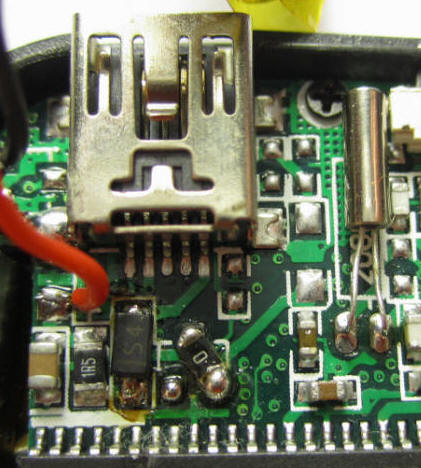 #3-9 camera repaired. Replaced the bad diode (replacement labeled S4) and re-soldered the crystal. |
| 101126 - #3 Charging Circuit Problems |
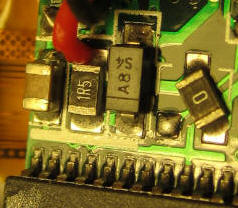 SYMPTOM: SYMPTOM:
Camera owners and sellers have reported problems with LiPo battery charging. The most obvious symptom is that the LED flashes continuously when the USB is connected, indicating that the battery is not fully charged (4.2V). It never fully charges. One of my own #3 cameras would not charge the battery above 3.9V no matter how long it was connected. Normally, one hour is enough to charge the battery. PROBLEM DESCRIPTION: The diode (labeled A8S4) is bad. PROBLEM HYPOTHYSIS'S: 1. When the USB cable is connected, the USB voltage (nominally 5V) pulls up the battery through a diode (A8 S4) and a resistor (1.5 ohm 1R5). This circuit intends to charge the battery and supply current to operate the camera. The current through the diode will be large and even larger when the battery voltage is low. The current is limited only by the resistor, cable resistance and the forward voltage drop of the diode (nominally 0.55V). The current exceeds the absolute maximum for the diode, damaging it. The damaged diode forward voltage rises above 0.9V. 2. The diode does not meet specification and is damaged by less than the absolute maximum current. 3. The diode was installed defective and never tested and the battery was installed fully charged. PROBLEM ANALYSIS: Bad engineering. Bad design. Bas quality control. Bad diode in the charging circuit. High resistance USB cable. The charging circuit consists of three parts: 1. a diode (sometimes marked A8 S4) in series with 2. a resistor (about 1.5 ohm, sometimes marked 1R5) pulled up to USB voltage (nominally 5V). 2. a battery module that has a LiPo battery and a protection circuit that disconnects the battery above 4.2V. Engineering design considerations: 1. USB port voltage - compliant USB port voltage can vary from 4.75V to 5.25V. 2. Diode forward drop - a normal diode forward voltage drop can vary from about 0.3C to 1.0V, depending on the type of diode and the current. In this application the diode forward voltage is nominally 0.55V. 3. Camera operating current - While USB connected, the total USB current supplies about 125 mA to operate the camera and some additional current to charge the battery. 4. USB cable resistance - The power resistance of a 6 foot USB cable (ground wire + positive voltage wire) is about 2 ohms. This includes the resistance of the wire (usually about 28 gauge) and the connector resistance. So the cable added resistance, and resultant voltage drop, is part of the charging circuit. 5. Camera heat - The heat from the camera components might over-heat the battery. 6. When the USB cable is connected, the battery module functions like a very large low resistance capacitor. Pulling the battery up to USB voltage through a resistor and a diode will cause an enormous current limited only by the diode voltage drop, the resistor and the resistance of the USB cable. This current could exceed the absolute maximum current of the diode, and possibly not be the correct current to charge the LiPo battery. 7. It is possible that some diodes are more susceptible to over current damage than others, so this failure might not happen in all cameras. 8. A resistor of 4.7 ohms is used in some Anyka 808 cameras. This might limit the current, prevent diode damage and lengthen the battery charge time. 9. Using any compliant USB voltage (4.75 - 5.25V) should be OK. With this diode problem, using a high USB voltage will charge the camera faster but might damage the diode. Using a low USB voltage might not charge the battery fully. Reports are that some external USB power sources (AC powered or battery powered) work well so they probably provide this higher voltage. PROBLEM EMPIRICAL EXPERIENCE: My desktop computer USB voltage is 5.14V unloaded. At the #3 camera circuit board the USB voltage with a 5 foot good USB cable is 4.97V (a cable drop of 0.17V), the diode drop is 0.92V (indicates a damaged diode), the resistor drop is 0.17V and the battery module voltage is 3.88V. So the USB current (0.17V / 1.5 ohms) is only enough to keep the camera powered, and nothing charges the battery. In this situation it will take forever to charge the battery to 4.2V. I removed the battery module and verified it is good by charging it on a external LiPo charger. On my Dell laptop, the USB port voltage is 5.14V unloaded. 5.07V at the #3 circuit board through a USB adapter. The diode drop is 1.42V (indicates a damaged diode). That is a defective diode as noted in this report. SOLUTION: 1. The charging circuit probably needs to be re-designed to accommodate various USB voltages and USB cables, limit the USB current, choose a diode that will survive, and produce the correct current for both the camera and the charging battery. 2. Replacing the diode might temporarily or permanently make the camera functional. If the replacement diode is more tolerant of over-current, it might last. If the diode is bad most consumers can't fix it. It takes an experienced SMT technician to replace that diode, and find the correct replacement. 3. Replacing the bad diode, and replacing the resistor with a 4.7 ohm might work better. More bench research is needed. 4. Using a USB connection with low resistance (a short USB cable or a USB adapter) will increase the available USB voltage at the camera circuit board. |
| 2010 Nov 14 - Firmware Chip EEPROM Programmer |
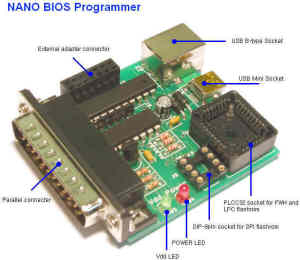  Roger
M. received an
EEPROM programmer (NANO BIOS Programmer)
from eBay (12 day delivery to the UK)
that can directly read and write the firmware flash SPI chip (SOP-8 package) in the camera. Roger
M. received an
EEPROM programmer (NANO BIOS Programmer)
from eBay (12 day delivery to the UK)
that can directly read and write the firmware flash SPI chip (SOP-8 package) in the camera.Roger had a bricked camera. He was able to un-brick the camera by reading the chip from a good camera, blanking the font, and writing it to the chip in the bricked camera. Rogers comments: 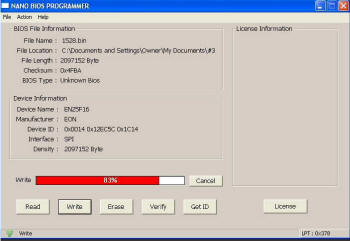 Included with the order is a SOP8 to DIL8
adapter, this one you have to solder on the IC then plug it into the programmer.
For a combined package total of less than $25 i thought that was money well
spent considering i have the soldering skills to keep soldering and removing the
IC's. I have now ordered a special SOP8 to DIL8 adapter from
this
eBay supplier this seller is the cheapest i have found so i do not have to keep
on soldering and de-soldering the IC. Included with the order is a SOP8 to DIL8
adapter, this one you have to solder on the IC then plug it into the programmer.
For a combined package total of less than $25 i thought that was money well
spent considering i have the soldering skills to keep soldering and removing the
IC's. I have now ordered a special SOP8 to DIL8 adapter from
this
eBay supplier this seller is the cheapest i have found so i do not have to keep
on soldering and de-soldering the IC. Until my new units arrive, I won't have an unmodified image to download to the programmer, so if anyone wishes to take a look, I have also included the 2MB datestamp modifed bin image that was saved via the programmer. File 4520bfdd 101114 C3 SPI Flash Dump.1528.bin in the C3 folder of the vault. NOTE: you can not upload this file using the ISP program. |
| 2010 Nov 15 - Report on New #3 Cameras |
| 101129 - Both #3 cameras
from eBay digitalele889 failed and were repaired.
See the report. |
| 101115 - Update - I opened
the case. The battery is unmarked. The processor is
SPCA1527A. The board is marked ND600V4. Great News - I installed old firmware from a #3 I received in September 2009 (CRC32 = a3cb0699). I did not know if the old firmware would work. The indoor missing frame rate dropped from 50-75% to about 18%. Wow! More testing continues. |
| 101114 - I received two #3
cameras from eBay digitalele889. 11 day delivery from Hong
Kong. This seller advertises the camera as the #3. Compared to the "genuine" #3 that we know, this camera has some disappointing problems. Based on the measurements, this camera seems to have an underpowered processor. Things that are the same: 720x480 video, 1280x1024 photo, 353Kbps audio, yellow video date time stamp in the lower right. I used a formatted PQi class 6, 4GB micro SDHC card to do tests. High missing frame rate - The FPS is 30.9 and the missing frame rate is high; about 50-75% for indoor lighting and 18-20% in good outdoor light. The missing frame rate is the lower number when the camera is stationary. A good #3 has less than 10% missing frames. Low total data rate - The indoor and outdoor total AVI data rate is 38 MB and 61 MB per minute, respectively. This low rate is partly due to the high missing frame rate. The camera writes missing frames as zero length records in the AVI file. A good #3 would be about 85 MB per minute. Tele AOV - The angle of view is 37 degrees, about 54mm equivalent. This is slightly more telephoto than I have seen on other cameras. Different firmware - I downloaded the firmware. The 1528.bin.brn file (CRC32 = F7037EF9) is different than my other #3 cameras. High video noise - There seems to be an excess of video noise. I will be opening the case and doing some more tests.. |
| 2010 Nov 04 - 808 Keychain Cam #3 Timestamp Removal - by Simon |
| Simon's instructions: How
to modify the #3 camera firmware to blank the font which will
disable the video date time stamp. Readme.txt file: http://www.rcgroups.com/forums/showatt.php?attachmentid=3571609 RCGroups post: http://www.rcgroups.com/forums/showpost.php?p=16446110&postcount=5954 |
| 2010 Nov 06 - Wildview Firmware Updates |
| Matt in Australia
found this interesting information. Wildview (www.wildviewcam.com)
makes some wildlife cameras that seem to use the Sunplus 1528
software. They publish firmware updates for some of their
products. ========== Comments from Matt: I have done some more research with irfanview on the firmware files and discovered that they all have hidden under the fonts a triangle with a exclamation mark inside it. Under that there is some other words. I managed to assemble them into the word 0 WILDVIEW (see attached file). 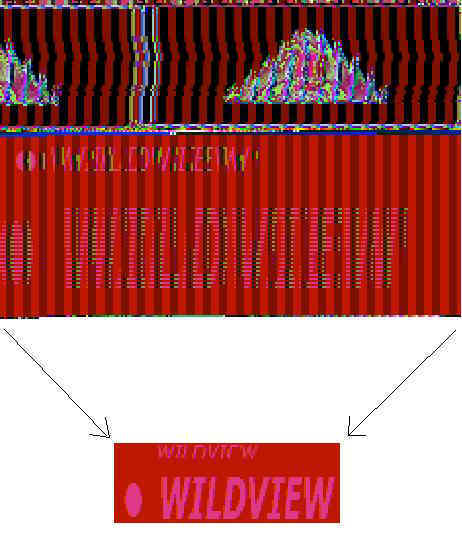 After a quick Google
search I discovered this web site http://www.wildviewcam.com
and more importantly the support page with these firmware updates
http://www.wildviewcam.com/downloads.html
(view the updates for the "Wildview Scouting Camera Firmware".) After a quick Google
search I discovered this web site http://www.wildviewcam.com
and more importantly the support page with these firmware updates
http://www.wildviewcam.com/downloads.html
(view the updates for the "Wildview Scouting Camera Firmware".)If you download any of these files you will find a PDF with firmware update instructions and in another zipped file there is these 5 file, 1528.bin DRAMPARA.TXT ISP.BIN ISPKEY.TXT OXOXOXOX.XOX If these files are loaded to a formatted memory card it is possible to update the firmware on the Wildview camera directly from the SD card. I wonder if it is possible to use some of these files to do the same on a 808 etc? This may be a quick way to update the patched firmware? |
| 2010 Nov 02 - #3 Video Date Times Stamp Removed |
| This is to report that I
removed the video date time stamp from one #3 camera. My
OS is Windows XP-32. 110109 CAUTION - Reports are that changing the firmware increases the missing frame rate. Even if you re-write the original firmware the increase in missing frame rate remains. If you try this, do it at your own risk. ISP.EXE (In System Programming) is used to download and upload the camera firmware. ISP is compatible with XP-32 and 7-32. ISP is not compatible with 7-64 (Tom, Carlos). If you get any errors, do not proceed. If something goes wrong you might brick your camera. Sometimes a camera can be un-bricked. If you try this procedure on a different operating system, email me with your success or failure. No guarantee that this will work for your #3 camera, and it might brick it. The risk it totally yours. This procedure has also worked with the gumpack camera that has the Sunplus processor and same electronics as the #3. Here is the basic procedure. 1. Downloaded the firmware from the camera and observe the file size. 2A. Blank the font in the firmware file 2B. Make sure that the downloaded file size matches the size of the new firmware 3.Upload the blanked font firmware file ========== I install the latest #3 webcam driver SPCA1528.rar. I connect the USB. I go into webcam mode (short press the #3 power button). I download driver.rar from the web. I extract the isp rar file from the driver.rar file. The isp rar file might look like "isp⟨⟨⟨⟨⟨⟨.rar" or "isp(软件工具).rar". Then I extract the files in that rar file. The isp.ini file needs to be edited. I correct these paths so they are correct for my computer: ParamFile =C:\Documents and Settings\All Users\Documents\SYS_REG_DS64_D96C96_SPI_12Mhz.TXT IspFile =C:\Documents and Settings\All Users\Documents\ISP_SPI.BIN FwFile =C:\Documents and Settings\All Users\Documents\1528.bin.brn  The ISP program is used to download (#3 to PC) the firmware or upload (PC to #3) the firmware. When uploading use the brn file, not the raw file. I run isp.exe. I press the "Ver. Check" (version check) button. If ISP displays like this The ISP display is something like this:  I press the "Read [F6]" button. I am asked for a folder name for the download files. Files and folders (from #3 to PC) are downloaded. The important files are: SYS_REG_DS64_D96C96_SPI_12Mhz.TXT ISP_SPI.BIN 1528.BIN.BRN  The NoTimeStamp program will blank the font in a bin.brn file. The input and output file will be the same size. I run NoTimeStamp.exe written by isoprop. I specify source 1528.bin.brn and destination 1528.bin.brn.new. I press Patch! I press Exit. I press the ISP [F5] button. I specify SYS_REG_DS64_D96C96_SPI_12Mhz.TXT, ISP_SPI.BIN, and firmware file 1528.bin.brn.new. I press the OK button and wait up for a few minutes (45 seconds on my computer) for the upload (PC to #3 firmware write) to complete. While uploading Windows will make sounds to indicate USB connect or disconnect. The ISP program looks dead (no activity indicated), but be patient and wait. When the firmware is successfully uploaded, The ISP displays something like this: I disconnect the USB. I reset the camera. Then if the camera seems dead, I do the next step. The camera does not respond so I connect the USB, wait until the LED comes on, then immediately USB disconnect. The camera seems OK and can be turned off and on. I take a sample video, and play the AVI file. Video Date Time stamp is gone. |
| 2010
Oct 30 #3 Firmware Mod Downloading (#3 → PC) and Uploading (PC → #3) Removing the Date Time Stamp |
|
| CAUTION Use at your own risk.
|
|
| Roger M. has completed 4
videos and a setup package for the #3 808. ========== Comments from Roger M.: I'm in the process of making an upload firmware video and possibly a modify 1528.bin file video too so owners can modify their own bin file. The setup package has a modified 1528.bin file which has the datestamp removed. Another #3 owner, Simon, used the file on his #3 and it worked. Step-by-step process: 1) Download and install setup package - #3 ISP (In System Programming) tool, webcam driver, webcam viewer, modified 1528.bin file. C3 variant 808 setup files.rar 2) How to setup software package http://www.youtube.com/watch?v=En_bjjgyyyY 3) How to put camera into setup mode http://www.youtube.com/watch?v=V7JBxnZLJds 4) How to download firmware http://www.youtube.com/watch?v=PBY4v9hgA24 You are doing this at your own risk. If you have any doubts, do not upload. 5) 101108 Uploading (PC to #3) the firmware. http://www.youtube.com/watch?v=3gaaNuD1vDs |
| 2010 OCT 04 -
Removing the #3 Video Date Time Stamp - Using the ISP (In System Programming) Tool to Dump the Firmware, Edit Out the Font from the Firmware, and Reload the Firmware. |
|||
| 101030 Update - See
#3
Firmware Mod |
|||
| Roger M. in the
UK has found the way to download (camera to PC) the #3 camera
firmware! He is using the SunPlus ISP (In System
Programming) tool. SunPlus makes the processor in the #3,
#6 and #8 cameras. Photos Below↓ ===== Comments from Roger ===== 2010 Oct 03 22:00 - I read up about the MIQI Q7 camera and the subsequent driver package that i found some very interesting stuff. I have managed to download the firmware of a #3 808!!!! :) using the ISP program that came with that driver package that you have linked to. I have included some pictures of it working. The first picture is proof that ISP can see the camera. The second picture is start of the reading process, I'm about to select the location where to save the files it downloads from the camera. The last picture shows the reading complete. The files it reads from the chip are as follows: 1528.bin 1528.bin.brn Res_0x100 2 Directories of Res files A & B Directory A - 70 Res files Res_0x0 to Res_0xf Dirctory B - 2 files, Res_0x80, Res_0x81 How to get ISP and the #3 camera to work was as follows. By the way, setup mode seems to be the same key press function as putting the 808 in webcam mode. Make sure the 808 is switched off, keep you finger pressed on the 808 mode (photo/video) button then plug in the USB cable. You will hear a few beeps from your computer indicating that it has seen the 808. First time connecting on my PC brought up new hardware detected so i installed the webcam drivers. When you have heard the beeps, the light should be on the 808 so now you can release your finger off the 808 mode button now. 1) Had to find a know working USB lead, i tried 3 and all would no go into setup mode. I'm actually using the USB cable from my Motorola Razor V3 phone. It works every time. Anyway, to confirm that the ISP program can see the #3 808, i press the Verify button, look at picture one to see what the result is you should be getting. If it does not work, you will get 'USB connection error' displayed. 2) If you wish to read the contents of the #3 IC you must change the directory listing in the ISP config file to match the location of where you have unzipped the archive. NOTE: The ISP program does not like spaces in the command line so don't save the archive to a location that has spaces in the listing like 'C:/Documents and Settings/' When i tried to read, it would just hang. The line that needs changing is IspFile = .If you notice on the screen grab i've done on picture two, you will notice that it says C:\ISP_SPI.bin so in the ISP configuration file, the command line was changed to IspFile =C:\ISP_SPI.bin 3) When your ready to read the contents of the IC, just press the Read button, this will start to download files of the #3 808. If you look at picture 2, it asks you for a location where to save the files, once you've choose a location, it carries on reading the contents of the IC. 4) Picture 3 shows what a successful read looks like. I've only downloaded the contents of the #3 808. I've not done any further checking because it's now 3am and i'm exhausted. Hope my investigation helps many others out there. |
|||
|
2010 Oct 04 07:00 -
Comments from Roger M. I wanted to let you know that while i have been able to download the firmware of a #3 808, I've not been able to upload it back. I have now bricked (killed) 2 units (how to un-brick). Have ordered another 3. This is getting to be rather expensive lol. Anyway, looking at the 1528.bin file that it creates when downloading the firmware, you get to see various parameter entries like 4 settings for the Video display, 3 settings for the audio, some settings for the camera module. Now looking at the various txt files in the ISP folder, it would appear that they are parameter data for the SPI chip. If you open up the txt files you will note that the data is unreadable. Data like this in a txt file usually means that another program was used to make the parameter entries but saved its data in its own format as a txt file, hence why it is unreadable to us. My own fault, i was still tired from the day before and used one of the pre-existing SYS_ txt files, uploaded it via ISP, it said it had written ok. I unplugged the USB, turned off the 808, but now neither of them will switch on. I believe the parameter data in the txt file i used was wrong for that type of SPI chip. There is a feature on ISP that when you click the ISP button, there is a tick box 'Param Only', when i ticked this then clicked ISP button, it indicated that it was trying to download, but because my unit is dead it would not work so i'm wondering if this option is ticked, that it would download the parameters from the camera. That's why I've ordered some more cameras so i can try. Also, there are 4 core files, NAND, NOR SPI and ISP_SST. I can only assume these relate to the ram chip on the unit and you must select the right one. So please, inform your readers that it's is not just a simple case of download the firmware of the camera, look for where timestamp data is then upload it again. We must make sure we have the right parameter file AND the right ISP core file. Get either of wrong and you've killed your unit, as i have. But the fun is in the trying though isn't it :) |
|||
|
2010 Oct 04 11:00 -
Comments from Roger M. Attached is a text file showing a list of possible parameters that i have found in the 1528.bin file that was downloaded off my #3 before i killed it haha, oh well. Anyway, I've done my best to show what parameters appear by using a hext editor to trawl through the .bin file. I am sure there are errors in there somewhere but an item of note that is worth pointing out is that it has a parameter to turning the datestamp on and off. I'm now seeing where the locations are for the text for the datestamp to possible but empty values there. Just like was done with the gum camera. I'll keep plugging along ==== #3 808 paramaters.txt ======
|
|||
|
2010 Oct 05 17:00 - Comments from Roger M. Here's some more info on the 808. Firstly, I've attached three files. One shows a hex edit of two different 808 firmwares. I've labeled the pictures accordingly new_fw and 808_3_fw. The new_fw image is taken from the .bin file that is on that Google source site and the 808_3_fw image is taken from the fw.bin file that i download from my own #3 808. You will notice that i have highlighted the version dates in both and you can see, the #3 version date (May 20 2009) is older than the one taken from that source site (Oct 10 2009), so if we ever work out how to upload to the 808, it might be worth using that fw.bin file just to see what happens. The third file (files.ini) is a list of the file names that correspond to the Resx0 files that gets downloaded from the #3 808. I can only assume that it may correspond to other 808 versions too, that's if anyone else tries to download the firmware, but if they do, at least they will know what Resx0 file relates to fw.bin and then they can use a hex editor to look for the version date. That source site you linked too is very useful. It is definitely related to a LCD media device because the source files show the model numbers of the LCD's that they are using, as well as the model numbers for the camera modules too. Will be interesting to see if anyone else manages to download the firmware off their 808. ==== files.ini =====
|
|||
|
100708 08 - Comments from Roger M. Using the same method as was done by those who timestamp hacked their gum camera (worked out on my own how they achieve it, i didn't email anyone asking how they done it), i've applied the same reasoning to the 1528.bin file that was download from my #3 808. You will notice from the two pictures that i have managed to remove the fonts. 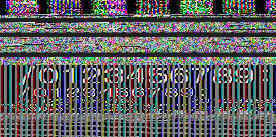 Their
site shows using InfraView to view their file as RAW. The
downloaded files i got with my #3 808, i used InfraView
in raw mode to check both fw.bin and 1528.bin and the fonts only
show up in 1528.bin. It is therefore interesting to assume that
both these files reside in the SPI chip or is the fw.bin in the
SPI and the 1528.bin in the SPCA1528 chip. I think the only way
of knowing for sure is to take off the SPI chip and read the
info off it directly by an
eprom programmer (something i plan in the future). But
for now, the fonts have been removed from the 1528.bin file. I
just need to figure out how to upload it to a new #3 808 when it
finally arrives. Their
site shows using InfraView to view their file as RAW. The
downloaded files i got with my #3 808, i used InfraView
in raw mode to check both fw.bin and 1528.bin and the fonts only
show up in 1528.bin. It is therefore interesting to assume that
both these files reside in the SPI chip or is the fw.bin in the
SPI and the 1528.bin in the SPCA1528 chip. I think the only way
of knowing for sure is to take off the SPI chip and read the
info off it directly by an
eprom programmer (something i plan in the future). But
for now, the fonts have been removed from the 1528.bin file. I
just need to figure out how to upload it to a new #3 808 when it
finally arrives. |
|||
|
101009 19 -
Comments from Roger M. Hi, have got some very good news. I have finally solved the problem of removing the time stamp from my #3 808 using the ISP software to upload a modified 1528.bin file. I've attached a very short video as evidence. You will notice that i have not fully removed the time stamp, you can still see some lines. The video is a shot of my table football pitch (subbuteo) but it is enough to prove that it can finally be achieved. The only thing i did different this time was to download the parameters off the 808 first and modify a different 1528.bin file (explained further in the message). If you press the ISP button, the next screen that appears, you will notice there is a small tick box titled 'Param Only'. I ticked this box. The other settings are as follows:- 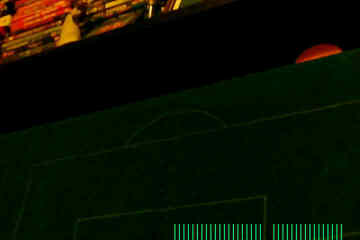 #3 camera, video frame, font almost removed, 1/2 scale ISP Core file = ISP_SPI ISP Firmware file = 1528.bin VERY IMPORTANT: You must carry out the the above download first otherwise i believe your 808 will just fail to power on. If you follow the steps in a previous post of mine to get it connected to ISP, making sure that the 'Param Only' tickbox is ticked, if you press ISP again, you will notice that it will download the parameter off the 808. I am assuming that it overwrites the file you have selected in 'Parameter File' because i cannot find the newly downloaded parameter file. Once you've done that, you now uncheck that 'Param only' check box, but before you press ISP button again, make sure the 'Read Verify' box is ticked. Now you can click the ISP button and you will notice that it will start to upload the modified 1528.bin file to your unit. Once it's finished i closed down the program and ran two steps that i found under the heading 'problems and how to fix them'. It is the last two, test 1 and 2. I carried out both these tests. Plugged in my SD card and as you can see by the test video, i have a result :). Oh yes, the modified 1528.bin file. This is probably where i went wrong the last time also. When you download the firmware off the 808, you get two 1528 files, a .raw and a .brn. Using a hex editor, i noticed that there are slight differences in the two files, so this time i chose to modify the 1528.bin.brn file. Using a hex editor i removed the font's for the date stamp. Saved the file and renamed it to 1528.bin. This is the file selected in the ISP program. I've just spent the last 6 hrs working on this problem and i can truthfully i am utterly overjoyed at my results. |
|||
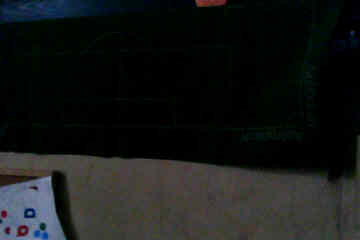 #3 camera, video frame, font removed, 1/2 scale I have just completed around 15 uploads to my #3 808 without any problems. I'm still not totally convinced about the parameter file even though i made a blank one. What i did was basically make an empty notepad file and saved it as Parama.txt. I then downloaded the parameters off my camera by selecting my new file as its location. The only thing is, the file is totally blank, nothing in there and the file size says 0 bytes. This potentially shatters my previous remarks about significance of using a correct parameter file when uploading bin files. It just seems weird that even though the parameter file I'm using is a blank file i made myself, the camera still functions ok. When my other 808 camera's arrive, i will see if just a blank parameter file, the isp_spi core file and a modified 1528.bin.brn file is all that is required. Now that i am continually modifying the 1528.bin.brn file, renaming it to 1528.bin then uploading it, I've had success in all the 15 attempts at uploading. The test2 video file i have just this minute taken after the 15th upload, so i know the process i am doing is working because i can repeat the process and have the camera working every time. With regards to the two font image files i sent you, i have recently found an error. If you look at an unmodified bin file you will notice two sets of fonts. The modified one i sent you shows the top set of fonts removed. During my investigation, i have recently found out that the top set of fonts relate to the date stamp on pictures, and the second font for the videos. I enclose a new test video and you will notice the date stamp has been totally removed. I had to return to the original 1528.bin.brn file and modify it all over again. This time i still have font issues with regards to pictures but you will notice those horrible lines have now gone. Therefore you will need to modify my original post on your site to reflect my error. Also find attached a quick how-to tutorial for downloading (camera to PC) #3 firmware. Have a look, give it a try and see if you can spot any errors in it. This way it gives the community a helping hand in downloading the firmware. English - 101010 808 C3 firmware download tutorial.pdf Spanish translation - 101020 Carlos Manual_descarga_firmware_C3-1.pdf |
|||
|
101010 05 - Comments from Roger M. With regards to the challenges now facing us 808 owners, I shall comment on each one. 1) There are two options, we try and explain how and where to edit the bin file, this method can cause problems for those who are technically challenged and might cause them to brick (how to un-brick) there 808. Or we get the owners of the 808's to download the firmware files and send me the 1528.bin.brn file of all the different variants. I can then edit the bin file and you could then post a repository on your site with all the variants and there modified bin file. 2) The only way i know of confirming the fw version of each variant is to check the date using a hex editior of the fw.bin, like i showed in one of the emails i sent you. I have not checked to see if there is a version date on the 1528.bin.brn file, that is something i've yet to do. If ALL #3 808 have the same hardware then the 1528.bn.brn modified file will work in it because the settings hidden in it are for the specific chips in there. It will only cause problems if the SPI chip or the RAM chip are different types. The SPCA1527A is common to all of them i am assuming. 3) You point out that the #3, #6 and #8 are all of a similar model. As long as can confirm that the 3 main IC's, the SPI, the RAM and the SPCA IC are all the same, moving fw.bin and 1528.bin files between models shouldnt be a problem, as below explains. The reason i know this is because as you know i bricked (how to un-brick) my original #3. I have a faulty gum camera which has the same exact hardware as the #3. So i desoldered the SPI IC off the #3 and replaced it with the one off the gum camera. When i powered on the #3, it came to life but get this, the button functions for operating #3 didn't work as they should have done, what worked was when i used the button press functions of the gum camera. Now it powered back on, I used ISP to put the original fw.bin and the modified 1528.bin.brn file over to the #3 and it worked, as by the test.avi video i emailed you. So lets recap, a SPI IC containing the fw and 1528 bin files off a gum camera with the EXACT same hardware worked on a #3 808. That's why i know that as long as the hardware in each 808 variant is the same for that model, the fw.bin and 1528.bin file doesnt really matter. I shouldn't brick the 808. But i can understand how many 808 owners might be skeptical about this so therefore i need to do further testing, but not have a many 808's of different variants, my testing is going to be very limited. Other Notes:- From my investigations of downloading and uploading files to the 808, I'm assuming that the parameter settings that get downloaded is unique to each camera hence why we see the differences in video quality. If you remember, the 1528.bin file shows various settings for the camera when you go looking in there with a hex editor. I need to do further investigations on this also because i am not 100% convinced that choosing the wrong parameter from the pre-existing list of files that came with the Q7 camera is what caused me to brick my #3, but i know that it is related somehow. If you look at the fw.bin file, there is a small section in there that deals with SPI and it is looking for 3 files, FW.BIN, 1528.BIN and DRAMPAR.TXT. My conclusion is, that it is the DRAMPAR.TXT file that includes the settings for the camera, the hue, backlight, stuff like that and the 1528.bin file interacts with this DRAMPAR.TXT file and matches the string values in there with the string values you see when using a hex editor. So, based on this, it should be possible to download the parameters off a #3 and reload them into a #8. The problem now facing us is lack of variants to try. Getting users of 808's to download files off there unit is the easy part because there is no uploading involved so it wont brick there unit. I've now got a seriously modified #3 that i can no longer confirm the integrity of using its data in other peoples 808's. To be honest, to help the 808 community further, i am going to need some good Samaritans who can send me a unit of each variant. Otherwise we are going to have to rely on other 808 users to also do a lot of the testing and investigation, as i have done. Apart from all that, things are looking bright for removing date stamp from the 808's. It just needs a lot of further testing before we can safely roll out our results to the community. As you point out, last thing we want is users bricking (how to un-brick) their 808's . |
|||
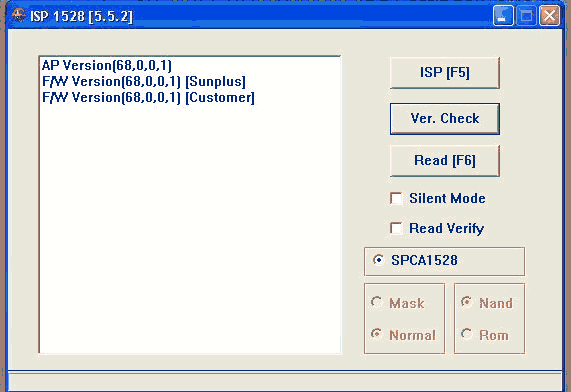 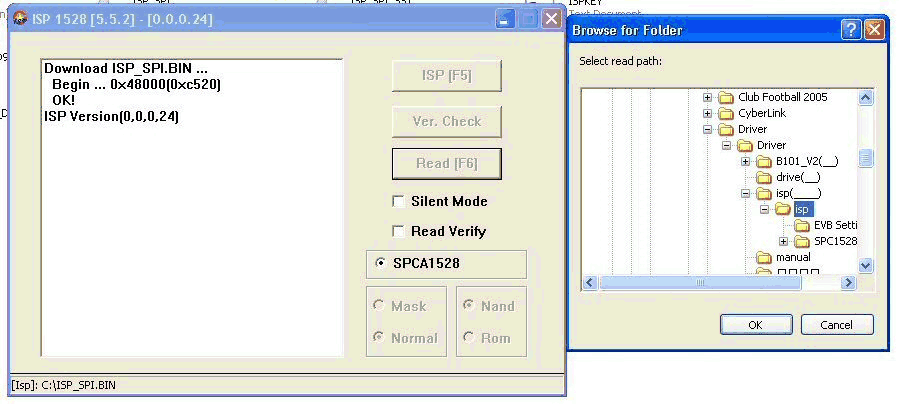 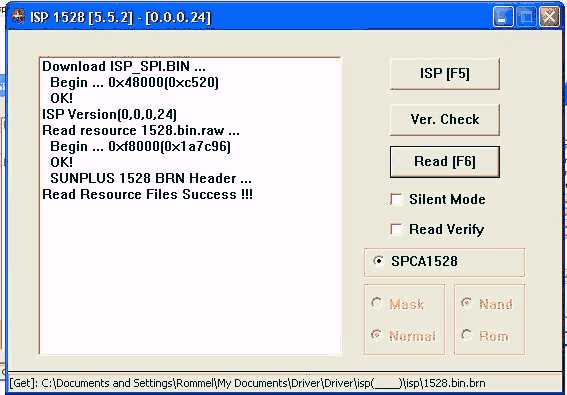 |
| 2010 Aug 25 - Misc |
| 100820 - googlebot |
| 2010 Aug 21 - #3 Camera Module Tear Down |
| InInside the 808 camera is a "camera module", sometimes called a CCM (compact camera module). I did a tear down on a camera module and here are the results. Even within a version of the 808 camera there are various camera modules used so the camera module in your camera might be different. |
|
Tear Down of a Camera Module, YouTube Video |
 |
 I
had a damaged #3 camera so I tore down the lens to see what is
in there. The optics consist of 4 plastic lenses and a glass
infrared blocking filter. I
had a damaged #3 camera so I tore down the lens to see what is
in there. The optics consist of 4 plastic lenses and a glass
infrared blocking filter. From left to right. 1. Plastic lens barrel. The threads seem to be 6 mm x 0.35 mm thread pitch. 2. Positive plastic lens. 3. Thin black lens separator. 4. Negative plastic lens. 5. Thin black lens separator. 6. Positive plastic lens. 7. Thick black lens separator 8. Positive plastic lens 9. Black lens separator 10.Glass infrared blocking filter. Broke during removal. 11.Plastic camera housing. 12.CMOS camera sensor, back side, shows 24 BGA (Ball Grid Array) solder points. Might be an OV7670 13.Flat cable assembly, showing 24 BGA points and 24 pin solder connector. |
| 2010 Aug 16 - Format in an External Reader |
|
Format the flash card in an external reader will give the largest free space.
The #3 does not size the card correctly during format, reducing 4GB free space
7.4%. 3745947648 free bytes - Formatting 4GB using my #3. 4060520448 free bytes - Formatting 4GB in an external reader. The #3 free byte size error of 7.4% happens to be the difference between the two ways that gigabytes are represented. Two to the thirtieth power, or 1000000000. (2**30 / 1E9) = 1.074. |
| Some Special #3 Tests | ||||||||||||
|
| 2010 Aug 16 - #3 Power Supply Research |
| Harry in Germany has done some great work identifying
the power supply circuits of the #3 camera. Schematics of
the Anyka cameras (#1, #7) are available here:
https://www.chucklohr.com/808/#AnykaSchematics. Here
are comments from Harry. What I also tried to find out is how the low battery detection works. Normally, my camera requires at least 3.55V to start, during operation 3.45V are required, otherwise the LED starts flashing. I found two resistors, that seem to be resposible for setting the battery voltage detection. There is a voltage devider, made up by a 2Meg and a 1Meg resistor. The divided voltage is then evalutated by the µC. By simply changing the resistors, one can modify the voltage the µC measures. I tried a 9Meg4 ( 2 x 4Meg7 in series) in parallel to the 2Meg. With this modification, the camera was still on with only 3V from a laboratory power supply. In this case the supply voltages (i.e. the 3V3) are no longer regulated to the nominal value. Anyhow, the camera was still recording. The picture quality of the video was not obviously affected, but below 3.6V the audio had the noise (motor boating?), below 3.4V there is no sensible sound at all. Of course, manipulation the battery voltage detection will have some drawbacks: * the battery will not be protected against over- or undervoltage, * sudden shutdown and loss of data once the voltage is too low, * different Micro-SD-card might not work and * (as already mentioned) no sound. |
|
#3 camera power supply circuits, by Harry in Germany |
| 2010 July 28 - If Flash Full, Will Not Record |
| EH has this
comment about his #3 camera. My biggest problem was ... trying to get the #3 into video record when it is full. Once full, you can hold the mode button down forever and the LED never blinks. |
| 2010 July 26 - #3 Report |
| JC has these
comments about the #3 camera.
Here are my preliminary
report on version 3 using a PQ1 class 6 Micro SD card.
My result were NICE AND SMOOTH
and CLEAR with no frame jumpiness even at the stock 30
frames per second firmware configuration setting. The
version 3 seems to focus sharp closer up than version 7.The
audio was nice and sharp. A little too sharp actually with
pop like crackle feedback at louder voice or sounds. I
noticed the audio recording seems to automatically raise and
lower according to the loudness. I wonder if this
observation of mine is true or not.
|
| 30 Dec 2009 - Q&A About Features and Problems with the #3 Camera |
| Here are some common questions that I get
through email about the #3 camera. Most of this Q&A does not
apply to the other camera versions. Two important notes: Rechargeable LiPo batteries can be dangerous if damaged, over loaded, over heated, over charged or mishandled. Voltages are live on the circuit board at all times, even when the camera is off. Q. Which camera should I buy? A. Buy a #3 camera. This camera can be identified by the external micro SD card, and the 720x480 AVI video file. See this YouTube video for an example of why the #3 is better than a #1 camera. The #3 has good video quality and is more reliable (YMMV). The camera is usually cheaper than a #1 or #2 because it does not come with flash memory. You provide a micro SD Flash card. The #3 comes in a number of variations but you usually don't have any choice about that and the seller does not know about it or mention it. There are at least two lens variations with different AOV (angle of view), and the circuit boards have been upgraded on some models for what purpose, I'm not sure. Don't buy a #1 camera. Many people have problems with it. Some people like the #2 camera because some versions of it it have few dropped frames and the video aspect ratio is not distorted. It is hard to identify who sells it. The #4 camera has some desirable features including an audio mode and date time stamp removal. The video color tends to be oversaturated. It comes in many variations. The variations with video frames larger than 640x480 have a bad duplicate frame rate problem. Sometimes, the #4 camera and the gumpack camera have the same electronics. Q. Who should I buy a #3 camera from? (100620) A. I don't recommend any specific seller. The buying risk it totally yours. SELLERS WHO SELL THE #3 CAMERA - For a long time the sellers of this camera (mostly in China) have not known what version they are selling, so each delivery might not be the camera version that you wanted or expected. Now there are sellers who know the versions and sell by version number. Here is a list of businesses who sell the #3 camera. SELLERS WHO SELL THE #? CAMERA - If you don't buy by version number, you don't know what you will get. Most eBay sellers are in China and don't sell by version, but they have a great price. One buyer strategy is to watch the latest posts to forums, like this one, to see who bought from whom, and what version was delivered. Then buy from a seller who sold the version you want. Then hope you get the right version. In the past these eBay sellers sold the #3, but maybe not anymore: joymyzone, myzone50, eletoponline365, metapark. There are many other sellers. From China the total delivered cost for one camera (without micro SD card) is usually US$9 to US$19. Delivery time from China to USA is usually 2 to 3 weeks, but can be 1 to 5 weeks. With a #3 camera you need a micro SD or SDHC card. If you buy online, don't buy from anyone on the list of eBay sellers who sell products with bad flash. Often a local sale price on a flash card is close to the online price. Always run H2testw at least once on every flash card you buy. Whoever you buy from, you take a risk. This product is unusual in that the manufacturers don't identify themselves and many sellers know almost nothing about what they are selling. If you ask a seller a technical question they often won't know the answer. If you have to return a bad product to somewhere in Asia the delay can be a month or more. Delivery time, product quality, return policy, product cost, shipping cost, these all vary. Buy from a seller who has a good reputation and you reduce your risk of a bad experience. You don't have to buy from eBay. Google "808 car keys micro camera" to find sellers who are not on eBay. Read the RC forums to get reports from buyers. Look at the eBay seller feedback ratings. Look at the list of eBay sellers who sell products with bad flash and don't buy from them. Q. Do you have operating instructions, and how can I set the date time? (100404) A. Links to operating instructions and how to set the date time. Q. Webcam - When I connect the camera as a webcam I get a new network connection. Under "Network Connections" I get "Local Area Connection 2, Microsoft TV/Video Connection". A. This is a normal part of the webcam driver. When you disconnect the webcam and reboot your computer this will go away. Microsoft Support about this. Q. Webcam - When I use the camera as a webcam can I use the camera microphone as a webcam microphone? A. No. There is no audio driver for the camera microphone. The camera microphone is disabled in webcam mode. The webcam driver is for video only, not audio. As a webcam the camera installs as two camera devices: 1. General still camera device, Sunplusmm, bulk1528.sys 2. General video camera device, Sunplusmm, sp5x_32.dll, dext1528.ax, ca1528aav.sys, and others ... Q. Webcam - In webcam mode, why is there is a large vertical oval over the left side of the image? (100324) A. See the Webcam Button Trick. There are two "button trick" ways to enter webcam mode, a good way (no oval) and a bad way (oval). That is a known problem and can't be removed. (100504)  Q. The USB cable that came with my camera works with my
camera, but does not work with my GPS.
Q. The USB cable that came with my camera works with my
camera, but does not work with my GPS.A. It's a bad USB cable. Many of the USB cables that come with these cameras are bad. Replace the cable. Q. I just received my camera and it doesn't work. A. The camera has a rechargeable LiPo battery. It needs to be charged for 2-3 hours 1 hour by connecting the USB cable. The camera will not work without a memory card (micro SD flash card). You have to supply and install a memory card. Q. The LED blinking indicates that the battery is charged or isn't charged. A. Unfortunately, the LED is not a good indication of battery charge. Connect the USB cable for a while to charge the battery ... use your own experience and judgment to decide for how long. Q. Can an 8GB micro SD card record a longer video than a 4GB micro SD card? A. A larger card can hold more video time than a smaller card, but there are these factors that can limit how much video you can record: 1. the size of the micro SD card 2. the full battery capacity is about 4GB of recording and then the battery will be pretty much discharged 3. an AVI file can't be larger than 4GB (about 50 minutes). 4GB is the file system limit. The newer #3 cameras never hit the 4GB limit because they have a close-and-continue feature. When an AVI file gets to 30 minutes, the camera closes the AVI file, and starts another AVI file. 4. the image content of the video. Like a JPG file, the MJPG AVI file size will be larger if the frames do not compress well. I have measured AVI data rates of 54 to 82 million bytes per minute (about a 50% variation). Wikipedia article about MJPG. Q. Can I record a single video longer than 4GB? What if I format the flash with NTFS? (100204) (100219) A. No. The flash must use the FAT32 file system. The camera will not work with the NTFS file system. Q. Are there any cameras that allow recording longer than the 4GB limit? A. Yes. The #4 camera will break a long video session up into multiple AVI files so that each file is smaller than 4GB. The battery and flash memory size limits still apply. Expect a short lost video gap between AVI files. The #4 camera also has some disadvantages. There are cameras that have a larger battery and record up to 4 hours: Q. Is there a way to increase the battery capacity? A. Yes, you could rig an external large battery. With a large battery there are still 3 factors that limits how much you can record (see above). To connect an external battery you need to know about electronics and batteries and know how to safely handle the internal rechargeable LiPo battery. You also have to resolve the conflict of what happens when you connect the USB cable. Does the external battery damage the USB port? Does the external battery charge from the USB port? Here is an example of an external AA battery project: http://www.rcgroups.com/forums/showpost.php?p=13477871&postcount=432 Q. If I start to record a video, and the size of the AVI video file hits the 4GB limit, and the battery charge is still good, what happens? A. The camera stops recording, and correctly closes the AVI file. The file will be a valid AVI file and slightly smaller than 4GB. To continue video recording, you have to manually start another recording by long pressing the mode button. The camera will not automatically start another recording. Q. Can I operate the camera as a flight recorder, that is, so that the camera is always recording and the most recent 10 minutes will be saved to the AVI file? A. No. Q. Is there a way to prevent the camera from displaying the date time stamp on the video? A. No. It can be sort of blurred out in post processing. Q. The LED is always on, or never on. A. Reset the camera (the reset button is through the side case hole). After using your camera as a webcam, you always have to reset it. Q. Is it OK to reformat the #3 camera micro SD flash card? A. Yes and No. (100526) Because of a bug in the #3 camera, formatting should be done in a good external card reader. Formatting the card in the 808 camera will "shrink" the device with each new formatting. Reformatting will destroy any files on the micro SD flash card. The #3 camera does not put system files on the flash card. The micro SD flash card is only used to store the video AVI and photo JPG files. The #1 camera partitions the internal flash memory into three partitions and puts system files on two of the partitions. Reformatting a #1 camera has to be done with caution. Q. I don't know if the camera or the flash card has a problem. A. Charge the camera, disconnect the USB cable and remove the flash card. Reset the camera. Press the power button. The LED should come on, flash 35 times and then go out. If this happens then the camera is probably OK. Suspect the flash card. Q. I suspect that the flash card has a problem. A. Reformat the card (destroys any files on the card), test the card, or try a different card. Reformatting (FAT32) can be done in the camera (connect the USB cable and run Windows format on the flash card) or in an external USB flash card reader. If reformatting does not fix the problem, test the card with the H2testw program. This test will take a long time, maybe hours. Q. The camera will only operate for a few minutes. A. This could be a camera problem, a rechargeable battery problem or a flash problem. First check the camera and the flash card (see answers above about how to do this). If the camera and the flash card are OK, then the battery might be the problem, and there is no easy fix for that. The battery can be replaced, but you have to find the correct replacement battery and be qualified to open up the camera and remove and replace a LiPo battery. It would probably be better to buy a new camera. Q. Do you have new firmware for the #3 camera? Is it possible to reload the firmware? (100108) A. I don't have firmware for the #3 camera. I don't know if it is possible to reload it. Q. Do you have source code for the #3 Camera? I want to modify the source code. (100204) A. No. Q. The micro SD card won't stay in the camera. How do I insert the micro SD card? (100114) A. Looking at the button side of the camera, the SD card goes in with the gold fingers up. The card has to be pushed in farther than flush using a fingernail or a ball point pen, then it sits in the camera flush. To remove it you press it in and it pops out. If the card won't stay in by itself, then the SD card slot mechanism is broken. Q. How do I get YouTube to display my AVI 720x480 video at the correct 640x480 aspect ratio? (100227) A. Every YouTube author can tag the video to display at a different aspect ratio. Go to YouTube and add this "tag" yt:stretch=4:3 to the video .You can do this while uploading or after uploading. The internal camera module takes a 1.33 aspect ratio (AR) 640x480 image but the CPU distorts this image and writes it to the AVI file with an AR of 1.50 (720x480). Q. I press the mode button to stop recording a video but the camera gets into a strange mode. Why do I have to press the power button to turn the camera off? (100324) A. Use a quick press of the mode button to reliably end a video. A long press will put the camera into a strange mode. Not a good user interface design. Q. Why does the video freeze for a few seconds at some points when I play the AVI video file? (100324) A. The video has long strings of duplicate frames because the flash card has poor random write speed. Try a different, better flash card. The micro SD card "class" is the sequential write speed and benchmarks show that every card is compliant. Even a compliant card can have poor random write speed. The only way to know the random write speed is to measure it with a benchmark program like Crystal Disk Mark. Q. My camera does not work. How can I test it? (100507) A. Test 1 - Remove the micro SD card. Reset the camera. Connect the camera to the PC. The camera should install as a mass storage device (a drive letter) and show the drive as being empty. Test 2 - Remove the micro SD card. Reset the camera. Long press the power button. The LED should turn on, flash 35 times, and go out. If the tests pass then suspect the micro SD card and try a different one, or reformat the card and try again. If either test fails then the camera is probably bad. If you are technically qualified you can open the plastic case and inspect the circuit board for a defect (a solder short, a solder open, an intermittent, or a piece of metallic debris) and correct it. If the defect shorted something, the camera might not be repairable. Solder defects can happen anywhere, but are more often on the hand soldered parts like the crystals (metal cans). Remember that the voltages are live on the circuit board at all times, even when the camera is off. Touching any metal to the circuit board can short something and destroy the camera, or cause a dangerous battery explosion. Before re-soldering anything, cut one battery lead. The parts are so small that very small re-soldering tools are required. |
| Update 3 Nov 2009 - New version #3 Camera - Preliminary Thoughts |

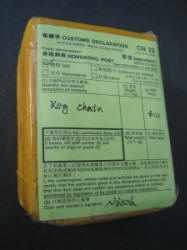

On 2 Nov 2009 I received a #3 type camera from eBay seller joymyzone. This seller had 100% feedback and offered a video sample. The price was US$16.98 (no flash card), with free shipping, and was delivered from Hong Kong in 19 days (YMMV). This camera uses an external micro SD card, so I am using a SanDisk 8GB micro SDHC class 2 flash card. I charged the camera for 3 hours before I used it. When plugged into a Windows XP USB port the camera was recognized as a mass storage device and an image device. Windows mounted the mass storage device (flash card) as a drive letter. It seems that some of these cameras come with an image driver on a CD but my camera did not come with a CD. I was able to set the date and time using the #3 camera method below. The overall image and video quality is much better than my old #1 camera. Empirical measurements (research methods to follow ...) ● Lens - 45 mm equivalent. The image AOV (Angle Of View) on the width is 43.36 degrees, which is the 35mm-camera-equivalent of a 45mm lens. See How to Measure the Focal Length. The camera orientation is horizontal with the buttons up. ● Image Shape Distortion - The camera takes an image at 640x480 (Aspect Ratio AR=1.33) and upscales it to 1280x1024 (AR=1.25) in the JPG file. This results in a slight shape distortion that makes circles look like tall ovals. ● Video Shape Distortion - The camera takes video at 640x480 (AR=1.333) and upscales it to 720x480 (AR=1.5) in the AVI file. If played back with square pixels the video will have a slight shape distortion that makes circles look like wide ovals. ● AVI File Rate - 54 to 82 megabytes per minute. Of the few videos that I have taken the AVI rate is 54E6 to 82E6 bytes per minute (3.24E9 to 4.92E9 bytes per hour). 54E6 = 54000000. The file size is limited to (4GB - 2bytes) because it's a FAT32 file system. ● Audio - The audio quality (in the AVI file) is good, but voice quality at less than 18 inch is sometimes over modulated. ● Frame Rate - 30.856 to 30.999. Based on 7 AVI files, the FPS varies as reported by VirtualDub. In one example file the FPS was 30.955 with about 7.5% duplicate frames. A standard rate is 29.97 or 30.0. In one file, of 200 video frames 15 were duplicates (7.5% duplicates). So the rate of unique frames is closer to 28.6 fps. The duplicates were not exactly periodic. Duplicates seem to happen about every 10 to 15 frames. In the playback duplicates are most noticeable when panning or tilting the camera. The rate of duplicates might be dependent on the frame content. Needs more research. Another note: ● USB Read Rate - 8600000 bytes per second moving an large AVI file from the camera flash to a computer SATA hard disk. ● Largest AVI File - Slightly less than 4GB. The camera will record video until the 4GB FAT32 file limit or the battery dies. I charged the battery and recorded the longest video that I could. The camera stopped recording at 3134 seconds (52 min14 sec) and 4293899576 Bytes (99.98% of 4GB) and it played OK. The recording rate was about 82E6 Bytes per minute. 4GB = 4294967296 Bytes. ● If No SD Card - Gene emailed me this description of what happens when the SD card is missing: Press the power button. The LED comes on, holds for 2 seconds, blinks 35 times, holds 1 second, and goes out. |
| 2010 July 30 - Sven's Time Lapse Videos and #3 Camera Mod | |||
Link to details (description, schematic and photos) of the mod.
The mod also deals with limited power. An external lithium ion battery is used and for every photo the camera is powered on, a photo is taken, and the camera is powered off. The PIC micro controls the power and mode buttons. Here are some of Sven's time lapse YouTube videos. Baltic Festival Karlshamn Sweden Main Square Baltic Festival Karlshamn Sweden Drottninggatan |
|||
|
Baltic Festival Karlshamn Sweden Main Stage |
Time lapse of street viewr /> |
||
| 21 Nov 2009 - There is a Webcam Driver for the #3 Camera |
|
Use this #3 webcam driver at your own risk. I can't support this driver. I don't host the
driver file. I do not have any responsibility for any problems
that this driver causes you or your computer. There is an
English and International version. I have only installed
and virus tested (nod32) the English version. I created a
restore point before installing this driver. I have
installed the driver on two Windows XP-32 computers with no big
problems (the Twain driver does not work). I don't know if
the driver works on Windows Vista or 98. Confirmed to work
on Windows 7-32.
● Go to this Thai language website
808 camera #3 webcam driver. |
| 2010 Feb 01 - #3 Camera, Focusing the Lens, f = 3.14 mm | |
| CAUTION The following requires that you open the camera case. The battery and the circuit board voltages are live. Any metal object can cause a short and destroy the camera. The LiPo battery is dangerous if not handled correctly. Do this at your own risk. |
|
Click images for full size 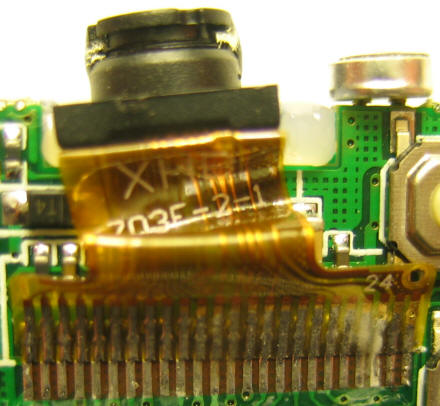 Camera #3, camera module showing glued lens ring  Camera #3, Camera Module, Glue Seal  Camera #3, lens tube, front  Camera #3, lens tube, glass plate glued to the back of the lens tube, back |
To adjust the focus you rotate
the lens ring.
Webcam mode is a convenient way to adjust the focus. Focus is one of the factors that can affect video quality. It is possible for the camera to be in focus, and still have low video quality because of some other factor. Before rotating the lens ring, use a knife to scribe a line in the camera lens ring and the camera body so you know the original setting. Place a dot of ink or "whiteout" on the lens ring as a position indicator. The lens ring is factory sealed in place with a drop or two of soft glue. To turn the ring you have to break that glue. I was able to break the glue seal on the lens ring and adjust the focus. After changing the focus, re-glue the lens ring. Otherwise, vibration might change the focus, or wobble the lens causing video distortion. A small rotation can make a big difference. On my #3 camera, a focus change from infinity to 60mm is a lens ring rotation of 120 degrees. The original focus of my camera was factory set at very close to infinity. 0.9 mm = f. The focal length of the lens. 3.14 mm = f. Calculated from AOV and sensor size. 5mm - the thread diameter of the lens tube. 0.35mm - the pitch of the threads 120 degrees - the rotation from a focus of infinity to 60mm. I get email asking if the focus can be adjusted. The internal camera module (internal lens, threaded lens ring tube, CMOS image sensor, flat cable, 24 pin connector) of both my #1 and #3 camera have the lens ring sealed with a drop of glue. This implies that the focus is factory set and sealed. For general purpose photography the focus would be set so that the far edge of the field of view is at infinity. To get the sharpest photography where most objects are at infinity, the focus should be set at infinity. The best focus for an RC airplane would be infinity. I scribed the camera and lens with a sharp knife to record the factory position. The lens ring (lens tube) is a tube that screws into the camera module housing. I turned the lens ring to break the glue seal. The glue on my camera is soft. You don't have to remove the lens tube to adjust the focus. I removed the lens tube. The lens tube is so small it is very hard to handle. Use jewelers tools if possible. Under a 10X loupe, you will see that everything is covered in dust. So when reassembling you need either a can of air or a rubber bulb to blow the dust away. A piece of dust on the CMOS sensor or the back of the lens could obscure dozens of pixels. The lens tube has a 5mm diameter thread with a thread pitch of 0.35mm (350 micrometers) measured with a 10X loupe. 0.35mm is a standard metric thread pitch. Looking at the face of the lens ring, one "hour" clockwise moves the ring in 0.02917mm (29.17 micrometers). The lens focal length is 3.14mm. See the calculations below. Small rotations make a large difference. The inside end of the lens tube has a coated glass plate glued in place, so the inside surface of the lens is sealed by this glass plate. 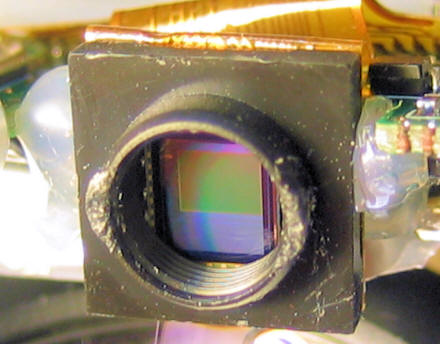 Camera #3, Camera module with the lens tube removed. CMOS sensor with optical image width of about 2.5mm. Threads shown. Hot melt glue holds the camera module in place. |
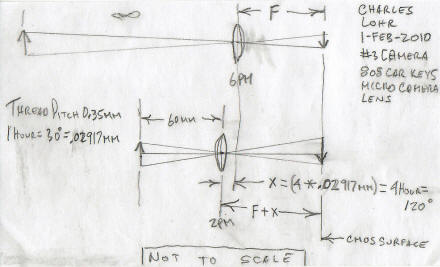 Camera #3, diagram of data used to calculate the lens focal length |
The focal length of the lens can be calculated from the angle of
view (AOV) and the width of the CMOS sensor. My #3 camera
AOV measured 43.36 degrees. The sensor width is about
2.5mm. This is the math to calculate f. tan(43.36/2) = (2.5mm/2) / f. f = 3.14mm = the focal length of the lens. By observation, this is correct. The following calculations attempt to calculate the lens focal length from two focal points, and the thread pitch of the lens tube. The results, f=0.9mm, don't match reality. More work is needed to understand the problem with this math. The focal length can be calculated by adjusting the lens focus from infinity to 60mm (an arbitrary number), and knowing the rotation of the lens ring and the pitch of the lens tube threads. Optical Formulas used to calculate the focal length of the lens 1/60mm + 1/(f+x) = 1/f = 1/60 + 1/(f+0.1167) Solve for f (the focal length of the lens) 1/f = 0.01667 + 1/(f+0.1167) (f+0.1667)/f = (0.01667*f) + 0.001945 + 1 The algebra becomes this quadratic equation: 0.9833*f2 - 0.8852*f + 0 = 0 Solve this quadratic equation for f at math.com f = 0.9002 So, the lens focal length is 0.9mm. |
 Camera #3, Focus 60mm, Lens Ring 2 o'clock |
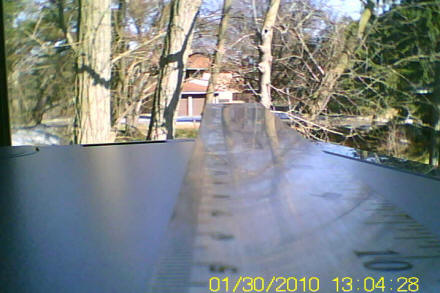
Camera #3, Focus Infinity, Lens Ring 6 o'clock |
| 2010 Feb 11 - #3 Camera - Date Time File Format | |
| Continuing the research done by
Dan, there seems to be some
confusion about the required file format of the tag.txt file. I did
some research by creating 17 different tag files and seeing
what the camera did with them. The results should apply to
everybody's #3 camera. "HxD Hex Editor" is a great free hex editor that allows the viewing and creation of any ASCII data in a file. The basic file format of the tag.txt file is: <whitespace>[date]<whitespace>YYYYxMMxDD<whitespace>HHxMMxSS<anything> <whitespace> is zero-to-many space (SP, 0x20), carriage return (CR, 0x0D) or line feed (LF, 0x0A) characters in any order. [date] "date" must be lower case. YYYYxMMxDD where "x" can be any character. HHxMMxSS where "x" can be any single character. <anything> is zero-to-many characters of anything. The following are valid examples of the date time in the tag.txt file for December 12, 2009 at 4:58pm (where . is a space) : |
|
| [date] 2009/12/29 16:58:00 [date]. 2009\12\29. 16-58-00 [date] 2009#12#29. 16,58,00. [date].......... 2009/12/29........... 16:58:00.......... . ... .[date] . ...2009/12/29 . .....16:58:00 . . |
[date] 2009/12/29 16:58:00 [date]2009-12-2916-58-00 [date]2009#12%2916@58?00 [date]2009-12-2916-58-00ABCDEFGHIJKLMNOPQRSTUVWXYZ [date] 2009-12-29 16-58-00 |
| 2010 Feb 23 - Podcast about the #3 Camera - "Daily Giz Wiz" Episodes 1029 and 1036 |
  Dick
DeBartolo and Leo Laporte have done a “Daily Giz Wiz” podcast
episode 1029 about the #3 camera. They are both experienced
gadget wizards and are amazed by the camera. A month ago I
helped Dick select a camera from eBay. If you don’t know, Dick
has been a writer for MAD magazine for decades, and wrote many of
the questions on the “Match Game” TV show. Dick
DeBartolo and Leo Laporte have done a “Daily Giz Wiz” podcast
episode 1029 about the #3 camera. They are both experienced
gadget wizards and are amazed by the camera. A month ago I
helped Dick select a camera from eBay. If you don’t know, Dick
has been a writer for MAD magazine for decades, and wrote many of
the questions on the “Match Game” TV show.YouTube video of podcast Giz Wiz 1029. Sample video from episode 1029 Dick took with his #3 camera. MP3 file of the podcast 1029 (8 MB, 18 minutes). Podcast description of episode 1029. Dick read a follow-up letter in episode 1036 (starts at 14:30). YouTube video of Giz Wiz podcast 1036. MP3 audio of Giz Wiz podcast 1036 |
| 2010 Mar 23 - Camera #3 - Oscilloscope Images | |
| Dimitri took these oscilloscope
images from the 24 pin connector of the camera module in a #3
camera. He counted the pins from the left to the right which is probably not correct? See #Camera2-DimitriData for the pin-out of the camera module connector. Data bytes are clocked out of the camera module at about 24 mHz. "You can see that data comes at double rate (1280 bytes per line) comparing to cam #2 (640 bytes per line). I think here we have 640 real pixels in the line." |
|
|
Pin 11 |
Pin 8a - line sync, one per line, about 65 us per line |
|
Pin 14, pin 11 |
Pin 8 - line sync, 480 per frame. |
|
Pin 14 vs data - camera outputs one data byte per clock |
Pin 6 - frame sync, about 33 ms per frame (30 FPS) |
|
Pin 11 vs data |
Pin 14 - camera output byte clock |
| 2010 May 22 - External Power Source for the #3 Camera | ||||||||||||
|
CAUTION - the battery and the
voltages on the circuit board are live at all times, even when
the camera is off. The
LiPo battery can explode and burn if not used, charged or
discharged correctly.
Proceed at your own risk. Many people want to take a long video but the internal LiPo battery capacity is too limiting. So what are the alternatives? FACTS LIMIT OF VIDEO MINUTES - The #3 camera will fill a 4GB (4E9 byte) card in about 1 hour, if the battery last that long. Most new #3 cameras have close-and-continue at 30 minutes where the AVI file is closed and the camera starts recording to another AVI file (there will be a few seconds unrecorded between AVI files). Old #3 cameras stop recording at 4GB. Close-and-continue will continue indefinitely until the flash card is full, the camera voltage ends, or the mode button is pressed. BATTERY MODULE - The internal LiPo battery module consist of a LiPo battery and a protection circuit. The protection circuit "disconnects" the battery below 3.0V and above 4.2V. It is very common for the battery module voltage to be as high a 4.9V when the USB cable is connected. If the battery gets below 3V it looses its ability to be charged. The protection circuit might also limit charge or discharge current. USB CHARGING - Connecting the USB cable (USB=4.75V to 5.25V) will charge the internal battery module. Once the battery module voltage rises to 4.2V it rapidly rises up to 4.9V. This rapid rise is probably due to the protection circuit "disconnecting" the battery. USB VIDEO/PICTURES - You can not power the camera through the USB and take a video at the same time. I have tried all voltages at the USB connector and the camera will not come on, take photos or take video. VIDEO VOLTAGE/CURRENT - The video recording voltage is 3.7V to 4.2V at the battery module . The camera stops recording below 3.6V (measured at 3.59V). The #3 camera current was measured at 155 mA with a SanDisk 8GB micro SD card, and 160mA with a Lexar 4GB card, so expect some variation depending on the card. Also, Philippe has noted "There are some spikes at 220 mA every 64ms. It’s probably when the SD card is written." These current spikes are probably responsible for the "motor boating" 15 Hz noise sometimes heard in the audio when the battery voltage is low. So here are the options: External power sources - Alkaline battery, NIMH battery, LiPo/Li Ion battery, LiPo battery charger, power supply, 12V automobile/motorcycle, RC battery pack (3.7 - 14.8V).. Configurations - Replace the internal LiPo battery module, Parallel the internal LiPo battery module. <<<<<<<<<< U N D E R C O N S T R U C T I O N >>>>>>>>>> |
||||||||||||
|
| 2010 June 13 - #3 Camera, Periodic Photo Project | ||
| 2010 March -
Walter modified a #3 camera to take a photo every 10 seconds.
http://www.youtube.com/watch?v=-4rdYI_cBJ0 Walter used a Microchip Flash-based 8-bit microcontroller PIC12F629. It periodically grounds with an open drain output transistor and one 10k resistor the button. It is simple and it works great! He added two switches. One to start the 12F629. Another to choose 3 or 6 photos per minute. He also added a connector across the battery to use an external battery charger or battery. The cam needs less power than in video mode. Approx 3550 Pictures can be stored in 1GB card. At 6 frame/min the LiPo Battery supplies energy for about 95min @ Temp 15Celsius. Time is less if the temp is lower. ========== 130503 HEX files are in the vault, folder C3, "100614 C3 Walter Mod.zip" V1: SpyPic629.HEX ... 34Pics per Minute V2: SpyV2629.HEX ... 03/06Pics per Minute - it depends on the switch "TIME SELECT" |
||
|
PIC 12F629 |
 #3 camera, Yellow wire is on the circuit point that gets grounded to take a photo. |
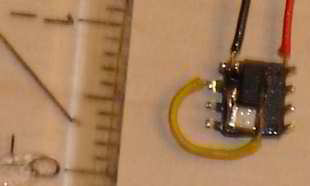 PIC micro and 1 mm per division scale. |
 #3 camera with mods. External battery connector, PIC micro, on/of switch. |
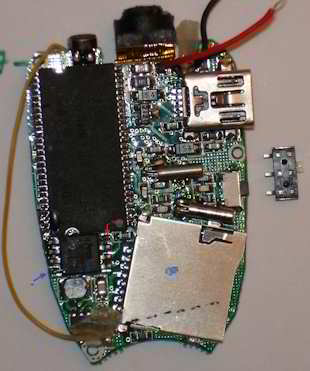 #3 camera and switch added to periodically take photos. |
#3 camera mounted |
|
#3 camera showing PIC micro wiring |
#3 camera showing external battery connector wiring. |
|
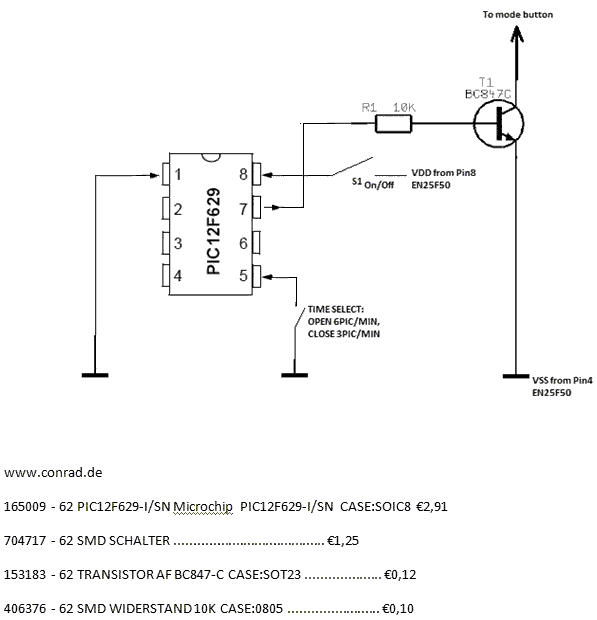 #3 camera mod showing PIC micro output connected to transistor that grounds the mode switch to take a picture. |
||
| #3 History | |
| 101126 | Charging circuit problem |
| 101127 | Update the charging circuit problem |
| 101130 | Add photos to #3 repaired |
| 110505 | Baidu SPCA SunPlus documents |
| 2010 XXX XX - XXXXXXXX | |

This work by Charles E Lohr is licensed under a Creative Commons Attribution-ShareAlike 3.0 Unported License. Google Analytics javascript is used on this page. Google Analytics Google Analytics IIS 6.0 There is no politically correct content on this web site. I have never owned an SUV. |